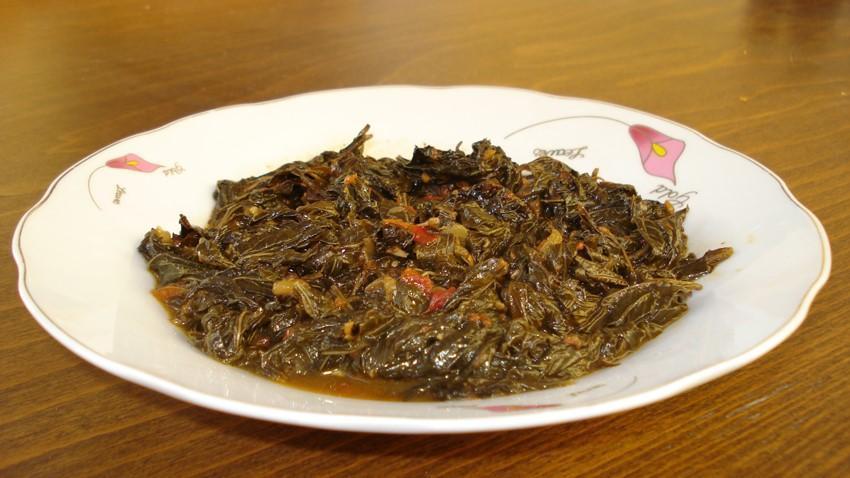Blending plates beyond borders

The moment our plane landed the Lefkoşe (Nicosia) airport, I realized how much I missed the island. North Cyprus used to be a regular stop for me, especially in early spring when it was just the right time for wild asparagus, the so-called “Ayrelli” in Cypriot Turkish. Cypriot cuisine is like a cornucopia of Eastern Mediterranean tastes, with many dishes similar to the usual dishes in Türkiye, yet so different, in such a local way. In certain ways, the Cypriot food sounds like the same language spoken with a strong local accent. And when it comes to accents, Cypriot Turkish is sometimes like a different language, especially when it comes to food names. It is fun to decipher the origin of certain words, actually the names give hints to various cultures that dominated or had influence on the island. Having such a strategic location in the Eastern Mediterranean, the island had always been a target for all imperial powers who wanted to control the sea trade. For thousands of years there has been a multitude of cultures in the history of the island; to name a few, Hittite, Mycenaean, Assyrian, Persian, Ancient Greek, Genoese, Eastern Roman, Syrian, Lusignan, Venetian, Ottoman and British states ruled here. The first known copper deposits in history belong to Cyprus, making it an important source of the metal and a major income for the island. The island actually takes its name from the Latin ‘cuprum,’ which means copper. The biggest trade item after copper was centered astonishingly on carobs; for centuries, carobs loaded from Cyprus ports opened trade routes to many civilizations in the Mediterranean. Today, one can still see carob warehouses from years ago in Girne (Kyrenia) Harbor. Beyond its own trade assets, the location of the island has also been a major factor influencing the Cypriot food situated at the crossroads of trade routes.
Food Puzzle
Cyprus definitely has its own world of flavors and its own culinary dictionary. As you trace the names of the dishes, you also embark on a journey of history, catching many clues about the past of this island. Sometimes names sound Italian, a legacy from the Venetian period, there are certainly Arabic origin names from the interactions with the Middle East
and Egypt during the Ottoman period, and of course, Ottoman food names and Turkish has many loan-words from Arabic, some of which were absorbed into Greek in the course of time, and needless to point out, some Greek words were adopted into Turkish. There are also English names from the lease of the island to the British that have seeped into the culinary lexicon. With the mixture of all of these, a completely different culinary language has emerged.
Navigating through the names of Cypriot dishes is like solving a fun food puzzle. One of the most-loved home dishes is the crowd pleaser "Magarına Bulli," which is almost obligatory to be served to important guests. It is simply a chicken & pasta dish, and although the dish is very local, the name has an Italian sound. “Magarına” is obviously derived from Italian pasta “Maccheroni,” and “Pollo,” which means chicken in Italian, became “Bulli” in Cypriot dialect. The reason that it is considered as a guest dish is because when guests come, you need to serve them something worthy, something precious and that is an egg-laying chicken straight from the coop in the garden. Sıdıka Atalay, a remarkable Cypriot businesswoman remembers fondly of visits to neighbors. She says, when we were sipping our coffees idly in the garden, there would be sounds of a chicken coming from the backyard, obviously running away from someone chasing it, then there would be deep silence, and then there would be the sound of plucking feathers, followed by the smell of burnt feather roots charred on fire, then the smell of chicken broth. I was a consequence of sounds and smells, with a final crescendo of taste. To make the dish, the chicken is boiled, the pasta is shaped by rolling it around a reed or wire one by one by hand, boiled in chicken broth, sprinkled with a generous helping of grated hellim (halloumi) cheese and dried mint, and served with shredded chicken pieces and some of the cooking broth. Such a feast!
Another favorite Cypriot dish is “molehiya,” which is like the national dish of Cyprus, is actually a common flavor in a geography of the Middle East and North Africa, stretching from Syria to Egypt towards to Tunisia. It is a taste one either loves or hates. For me, I don't like the Egyptian version, which is cooked more like a puree, but I love the Cypriot version with plenty of lemon juice, which is simply called “ekşi” in Cypriot Turkish, meaning justly “sour.” Molehiya is dried jute plant, cooked with lamb or chicken. If you don't add a lot of lemon juice, it turns gluey like okra.
Cypriot cuisine is rich in sour flavors, and has a whole array of pickles, some being quite odd. Pickled capers are called “Gabbar” here, a name coming from Arabic. One unusual pickle is whole-pickled “Pulya” bird, the tiny warbler, which is no longer allowed to be hunted. Another odd pickling item are the snails which are called “Garavolli” here. But the most interesting and still popular is “Bikla,” coming from the British “Piccalilli,” a cornucopia of pickled mixed vegetables, onion, cauliflower, celery stalks and carrots in a vinegar-based mustardy sauce colored bright yellow with turmeric. Every Cypriot table must also have “çakısdes,” — crushed green olives with must-have flavor coming from “Golyandro” seeds, which comes from the English word coriander. The list is endless, solving the food name puzzle is such fun, especially when it comes to hellim or halloumi which is the signature cheese for both the Greek and Turkish sides.
Flavors Across Borders
During the Cyprus Peace talks, the late Rauf Denktaş offered “Pilavuna” to Kofi Annan. As the name would make one think that it might have rice as an ingredient, as Pilav is Pilaf in Turkish, it does not contain a single grain of rice. It is a halloumi filled bun, called "Flaouna" in the Greek part of the country, and is generally made at Easter, while Turks mostly make it during Ramadan. Obviously “Flaouna” was corrupted into “Pilavuna” in Turkish, but it is fun to find out about the root of its main ingredient. The root of the Greek word “Halloumi” comes from the Turkish word “Hellim,” which comes from the Arabic word “Hilm” meaning soft. Even if the choice of Denktaş offering this shared taste was a subtle message of gastro-diplomacy, it did not have a softening effect on the road to a solution at the time.
Fork of the Week:
Cypriot flavors demonstrate a blend of cultures beyond borders. Such a demonstration was the reason I flew all the way to North Cyprus for a four-hand dinner by two chefs: Tolga Atalay, 5th generation Cypriot on his mother Sıdıka Atalay’s side, and Veli Bayraktar, Executive Chef of Girne Elexus Hotel for seven years. It was a completely unforgettable experience. After tasting the flavors, I once again straightened my confidence that peace can be brought through food, and that borders can be drawn with wires, but food can reconnect people. It was a culinary journey of tasting typical Cypriot dishes with the modern interpretations of two chefs. Kleftiko, which means thief, made with lamb or goat stolen from the herd, is a dish that every Cypriot would go to the other end of the island for. Stifado, on the other hand, is a dish seemingly from ancient times; the meat is cooked with honey and wine. It is just the right season for Cyprus. Both are favorites on both sides of the island. It hasn't gotten too warm yet and the first summer days are a delight. Of course, the unique flavors of the island also make Cyprus special, you cannot get enough of the different tastes at the several restaurants of Elexus, all with the special touch of Chef Veli Bayraktar.












